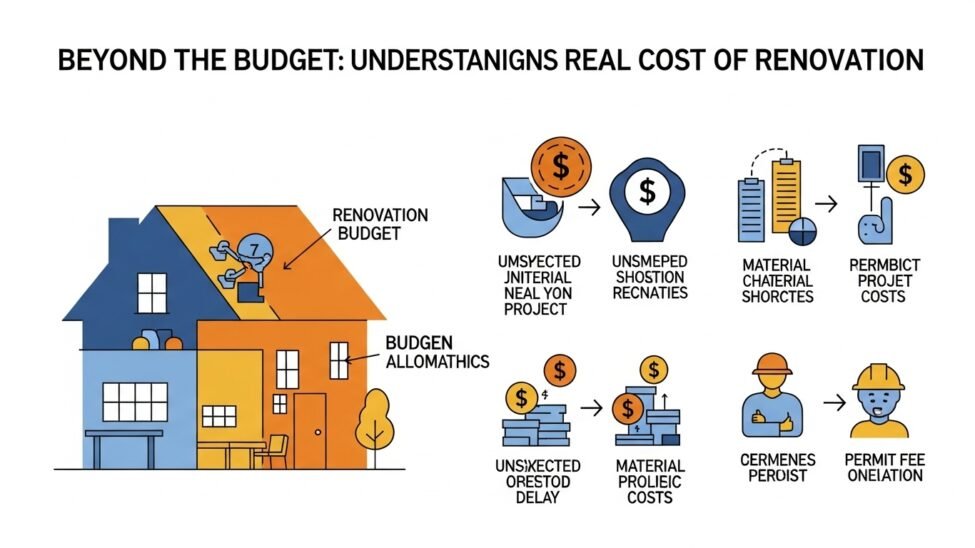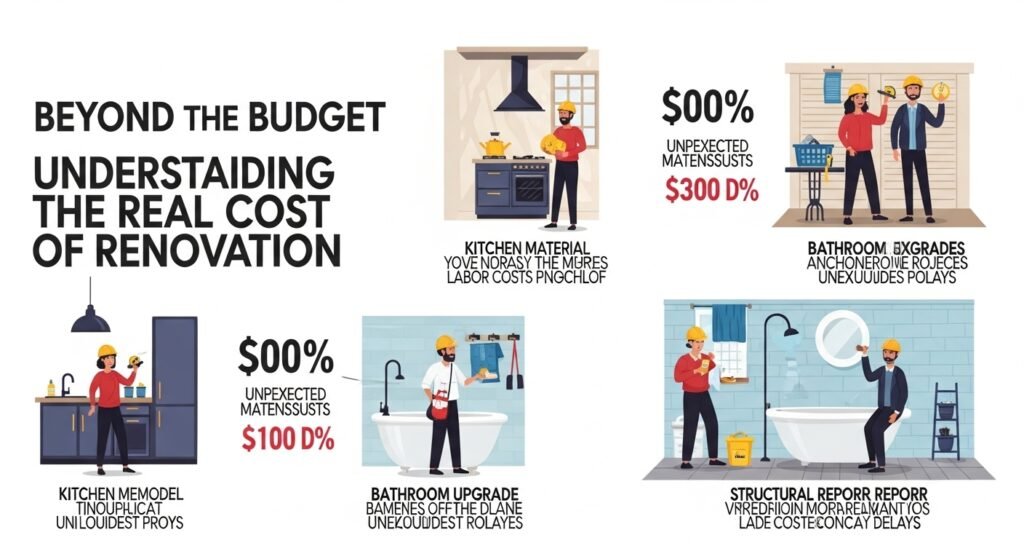
Beyond the Budget: Understanding the Real Cost of Renovation
Every renovation project begins with a vision. We dream of transforming our spaces, but the journey often requires more than just a financial commitment. Understanding the cost of renovation goes beyond the figures on a budget. It’s about the emotions, the stories, and the memories that dwell within our walls. Each decision we make can shape our lives and our homes in ways we might not expect. So, let’s explore this journey together, considering not just the dollars, but the value each change brings us.
Main Points
- Exploring the emotional and practical aspects of renovation.
- Understanding the true cost of renovation beyond just financials.
- Identifying key factors that influence renovation expenses.
The Hidden Expenses: Unpacking the True Costs of Renovation
As we embark on a renovation journey, it’s essential to acknowledge the nuanced terrain of hidden expenses. When we dive into remodeling our beloved spaces, we often underestimate costs lurking in the shadows. From unforeseen structural issues to the inevitable expense of permitting, every detail counts. Here’s a brief look at some common hidden costs:
- Unforeseen Repairs: Expect the unexpected; walls may hide moisture issues.
- Permit Fees: Navigating local regulations can surprise us.
- Material Upgrades: Choices may lead to budget creep, especially in remodeling.
The reality is that no renovation is ever truly complete without confronting these unexpected financial hurdles. By preparing for these hidden costs, we can turn dreams into reality without falling into a budgetary pitfall.
Budgeting Beyond the Basics: What to Include in Your Renovation Plan
When we think about a successful renovation, we often focus on the aesthetics and functionality. However, it’s crucial to dive deeper into the financial aspects of your plan. Creating a comprehensive budget ensures you navigate the unexpected twists along the way. After all, hidden costs can arise when tackling any remodeling project. Allocate funds for contingency, materials, labor, and even permits. Also, don’t forget some buffer for those unique features that make your space truly yours. A detailed plan not only inspires confidence, but it also steers us clear of budget-related pitfalls.
Key Aspects to Consider
| Item | Estimated Cost |
|---|---|
| Materials | $5,000 |
| Labor | $7,000 |
| Permits | $500 |
| Contingency | $2,000 |
Incorporating these elements will enhance our remodeling journey. Let’s embrace budgeting with creativity and clarity.
Navigating Permits and Regulations: Costs You Didn’t Anticipate
As we embark on our remodeling journey, it’s essential to recognize that hidden expenses can lurk behind every corner. Permits and regulations often feel overwhelming, lurking like silent sentinels, waiting to be dealt with. The fees associated with obtaining these permits can escalate unexpectedly, derailing our carefully laid plans. However, staying informed and proactive empowers us to tackle these challenges head-on. Let’s embrace the journey of remodeling with the knowledge that perseverance will lead us to our dream spaces—one step at a time.
The Impact of Design Choices on Your Renovation Budget
Every detail matters when we embark on a remodeling journey. Our design choices are pivotal; they can either stretch our remodeling budget or create unanticipated challenges. Imagine selecting high-end finishes, thinking they’ll transform your space, yet they can skyrocket costs. This is where we need clarity and balance.
Key Factors Influencing Budget
- Color Schemes: The mood shifts with colors, yet some hues may require more coats, affecting paint costs.
- Materials: Premium materials look stunning but often come with hidden expenses that can catch us off guard.
- Layout Changes: Shifting walls or plumbing alters not just aesthetics but significantly impacts labor costs.
Thoughtful design decisions ensure we stay within budget while achieving the dream space we envision. After all, striking the right balance is what truly matters in our remodeling adventures.
Time is Money: Understanding the Cost of Delays in Renovation Projects
When we embark on a renovation journey, time truly becomes our most valuable asset. Every delay not only extends our project timeline but also inflates costs in unexpected ways. Imagine a situation where each day of slow progress translates to extra expenses. It’s crucial to grasp that, in essence, remodeling isn’t just about aesthetics; it’s about efficiency. Every moment we waste could have been better spent enjoying our newly transformed space. We should strive for smooth execution, as this preserves both our finances and our enthusiasm for the remodeling process.
Embracing Efficiency in Renovation
We can’t afford to overlook the impact of delays. Let’s tackle our remodeling projects with urgency, channeling our energy into timely decisions and swift actions. Working effectively with contractors and scheduling wisely can make a significant difference. Remember, our time reflects our dreams. Let’s bring those dreams to life without unnecessary hold-ups.
DIY vs. Professional Help: Weighing the Financial Pros and Cons
When it comes to remodeling, choosing between DIY and professional help can be quite a maze. On one hand, we have the allure of saving money by tackling tasks ourselves. On the other hand, professionals bring expertise that might save us from costly mistakes. However, let’s not forget about time; our weekends may disappear faster than we expect. Can we genuinely balance creativity and cost? The key lies in evaluating our skills and the project’s complexity.
“Investing in skills today saves costs tomorrow.”
Cost Breakdown
| Factor | DIY | Professional |
|---|---|---|
| Material Costs | Lower | Higher |
| Labor Costs | None | Included |
| Time Investment | Significant | Minimal |
Deciding between DIY and professionals for your remodeling project requires careful consideration. Remember, less can sometimes cost us more in the long run. What’s your take? Are we ready to unleash our inner DIY adventurers, or do we need the steady hands of experts? It’s all about what makes sense for us.
Long-Term Value: How Renovations Affect Property Worth and Future Costs

As we embark on our remodeling journey, it’s essential to grasp how renovations can significantly influence property value. Investing wisely in your space not only enhances aesthetic appeal but also ensures future cost savings. Here’s what we should consider:
- Energy Efficiency: Upgrading to modern appliances and insulation can reduce utility bills.
- Curb Appeal: A fresh exterior can attract potential buyers and enhance market value.
- Functional Layout: Open-concept designs create more usable space, adding to desirability.
Ultimately, envisioning the long-term benefits of our renovations will guide us in making informed choices that resonate for years to come.
Conclusion
In conclusion, understanding the cost of renovation is crucial for anyone considering a home improvement project. Planning ahead can help manage expenses effectively. When we clearly define our goals and budget, we set ourselves up for success. It’s important to remember that unexpected costs can arise, but with careful planning, we can navigate these challenges. Embracing the journey of renovation not only enhances our living spaces but also brings a sense of accomplishment. Ultimately, investing in our homes is an investment in our happiness and well-being.
Frequently Asked Questions
What factors influence the cost of renovation?
The cost of renovation can be influenced by several factors, including the size of the space, the complexity of the design, the materials used, labor costs, and any necessary permits or inspections.
How can I budget effectively for a renovation project?
To budget effectively, start by determining your overall project goals and priorities. Obtain multiple quotes from contractors, include a contingency fund for unexpected expenses, and keep track of all costs throughout the renovation process.
Is it cheaper to renovate or build new?
Whether it is cheaper to renovate or build new depends on the specific project. Renovations can be less expensive if the existing structure is sound. However, in some cases, building new can be more cost-effective if significant renovations are required.
What are some hidden costs of renovation?
Hidden costs can include unexpected structural repairs, plumbing or electrical upgrades, permits, professional fees, and the cost of temporary housing if you need to relocate during the renovation.
How long does a typical renovation take?
The duration of a renovation project can vary widely based on the scope of work. Small renovations might take a few weeks, while larger projects could take several months. It’s essential to plan and communicate timelines with your contractor.





